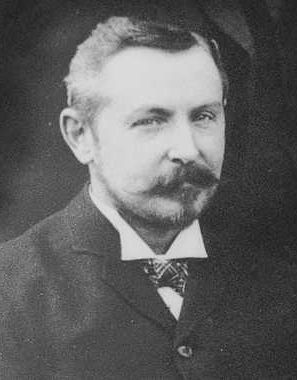George Ramsay

George Burrell Ramsay has, rather than simply a football administrator, been called the World's first "football manager" and not without reason. He would be Club Secretary of Aston Villa for forty years, guiding the English club to and through very much its most successful era. However, at that time there were already successful Secretaries at other clubs - Blackburn, Sunderland, Preston.. But, critically he did it not through obvious financial backing or due to who but by what he knew about how to do football, not just off-field but before that as player and trainer on-field too.
George was born in Glasgow in Tradeston, his father from Liff just by Dundee, with his own ironmongery business, his mother, the daughter of an Excise Officer from England with she born there too but brought up in Campbeltown in Argyll. However, by the time George was five the family was already prosperous enough to have moved out to Crosshill in the Southern Suburbs and it is there that he grew up, clearly a bright lad, remaining at school until he was sixteen. And he also, albeit unknowingly, had timing. The year was 1971 and football was about to explode right on his doorstep with both Third Lanark and Queen's Park within little more than a stone's throw.
Yet, whilst he was clearly immediately bitten by the footballing bug he turned out for neither club. He is said to have joined Oxford, the local Crosshill team, and Rovers, although not necessarily in that order. Both clubs had been formed in 1873, both played on the Queen's Park but with the latter more organised cum ambitious. Indeed Rovers was amongst the sixteen teams that in October 1873 entered the first ever Scottish Cup and in first round defeat had a G. Ramsay in goal. Oxford only entered, as did Rovers once more, the next season. It was defeated in the first round by Rangers as Rovers reached the quarter-final, then to withdraw for unspecified reasons. And Rovers was to do the same in terms of quarter-final the following season to be beaten in December 1875 by Vale of Leven but having had in the first round a walk-over itself; as none other than Oxford scratched.
And then several things happened. The first is that George Ramsay, notably now aged twenty-one, took himself off to Birmingham to work as a Brassfounders' Clerk. Then at some point probably in early in 1876 he took a walk through a park in the city's Aston suburb, saw some local lads kicking a ball about, joined in, on the basis of something between a season's and three seasons and a bit's involvement in the Glasgow game raidly showed them that he knew far more than they and was asked to join the football club, Aston Villa, they had formed a year or so earlier. And finally he met or even re-met two Scots brothers, the Lindsays, ironmongers themselves, who despite being born in then football-free Golspie in Sutherland seemed also to have had some knowledge of the game, presumably picked up in Glasgow too. Moreover, in Birmingham they were working at a forge in Perry Barr with a piece of land opposite, which George and one of the brothers were able to rent as the Villa's first ground, importantly one which could be enclosed so that to watch even amateurs the spectators could be made to pay.
The Lindsay brothers would soon leave Birmingham and return to the north of Scotland but Ramsay would remain and become Aston Villa captain and trainer, roles he after injury in 1882 would retain until finally stepping back in 1884. However, he was not to stay out of the Villa limelight for long. The decision was taken that the club, in a game that was now officially professional, needed essentially a "chief executive". One hundred and fifty applications were said to have been received. Ramsay understandably got the job, starting in 1886 and not stepping down until 1926. And during that time the record speaks for itself. There were to be six league titles and only one since, six runners-up, and only four since, six FA Cups and again only a single trophy since.

Yet when in 1893 George Ramsay was in West Bromwich to marry he did so still as a Commercial Clerk. His bride was Fanny Warwick, she aged twenty-two, he by then thirty eight and they were to settle close to Villa Park, moved into by the club in 1897, and have four children, three of whom would survive. But the marriage was ultimately not to be a success. In 1914 he divorced her for adultery and moved, still close to the ground, from Hampton to Trinity Road, where he in 1935 was still staying on his death. However, it, he aged eighty, actually took place in Llandrindod Wells, where he spent much of retirement time, a Scotsman, who managed in England and died in Wales, outlived by Fanny by more than thirty years. She would pass away at ninety-six in 1967 in Bromsgrove.
Birth Locator:
1855 - 14, Abbotsford Place, Glasgow
Residence Locations:
1861-71 - Dunedin Villa, 29, Albert St, Crosshill, Glasgow
1881 - 97, Aston Lane, Birmingham
1891 - 20, Heathfield Road, Handsworth, Birmingham
1893 - Hamstead Road, Handsworth, Birmingham
1897-1913 - 15, Hampton Road, Birchfield, Birmingham
1922 - 32, Trinity Road., Handsworth, Birmingham
1930 - 88, Trinity Road, Handsworth, Birmingham
1935 - 57, Trinity Road, Birchfield, Birmingham
Death Locator:
1935 - Llandrindod Wells, Radnorshire, Wales
Grave Locator:
St. Mary's Graveyard, Handsworth, Birmingham
Back to the Glasgow Southern Suburbs Trail,
or the SFHG Home